Networking. Wireless Communication Assignment
VerifiedAdded on 2022/10/02
|12
|2818
|37
Assignment
AI Summary
Contribute Materials
Your contribution can guide someone’s learning journey. Share your
documents today.
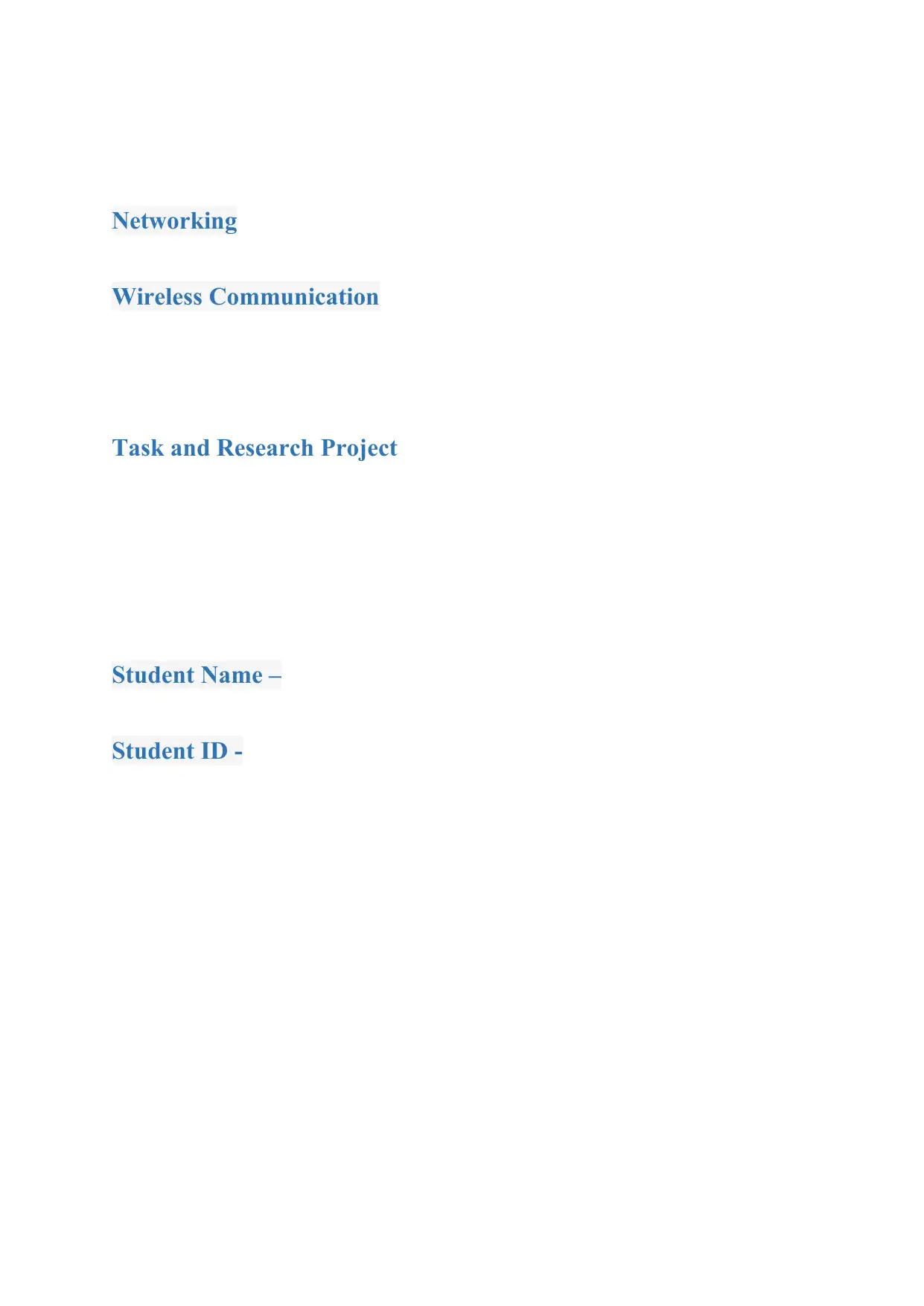
Networking
Wireless Communication
Task and Research Project
Student Name –
Student ID -
Wireless Communication
Task and Research Project
Student Name –
Student ID -
Secure Best Marks with AI Grader
Need help grading? Try our AI Grader for instant feedback on your assignments.

Task 1: Microwave Link Budget Design
Frequency = 20 GHz = f
Transmission capacity ( at both transmitter and receiver sides ) = 4 Mbps
Antenna diameter = 0.5 m = d
Transmitter
RF Output Power – High
Power Version:
+20 dBm At Transmission port
Tx RF Branching loss 2 dB From Transmitter to antenna
Frequency = 20 GHz = f
Transmission capacity ( at both transmitter and receiver sides ) = 4 Mbps
Antenna diameter = 0.5 m = d
Transmitter
RF Output Power – High
Power Version:
+20 dBm At Transmission port
Tx RF Branching loss 2 dB From Transmitter to antenna
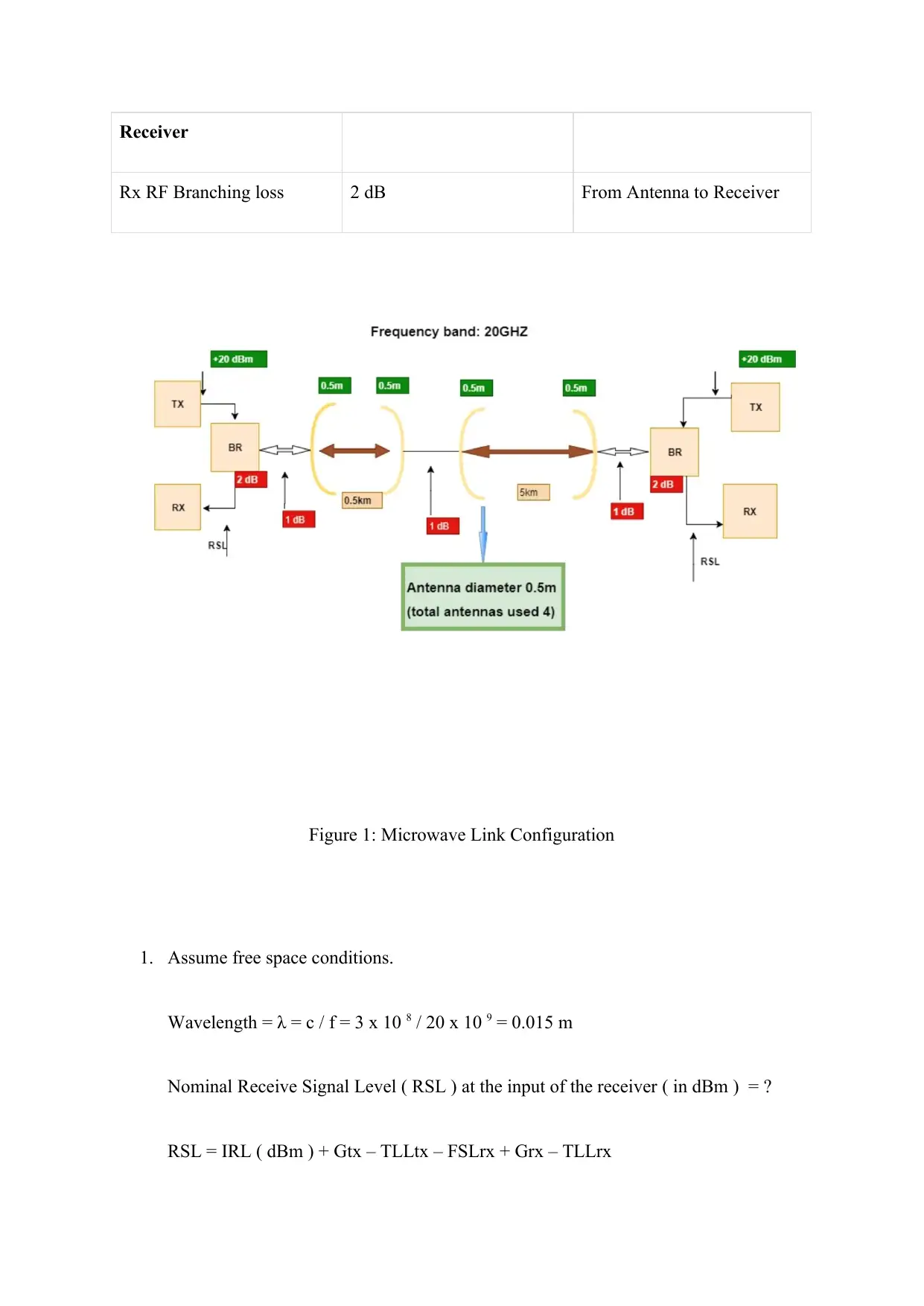
Receiver
Rx RF Branching loss 2 dB From Antenna to Receiver
Figure 1: Microwave Link Configuration
1. Assume free space conditions.
Wavelength = λ = c / f = 3 x 10 8 / 20 x 10 9 = 0.015 m
Nominal Receive Signal Level ( RSL ) at the input of the receiver ( in dBm ) = ?
RSL = IRL ( dBm ) + Gtx – TLLtx – FSLrx + Grx – TLLrx
Rx RF Branching loss 2 dB From Antenna to Receiver
Figure 1: Microwave Link Configuration
1. Assume free space conditions.
Wavelength = λ = c / f = 3 x 10 8 / 20 x 10 9 = 0.015 m
Nominal Receive Signal Level ( RSL ) at the input of the receiver ( in dBm ) = ?
RSL = IRL ( dBm ) + Gtx – TLLtx – FSLrx + Grx – TLLrx
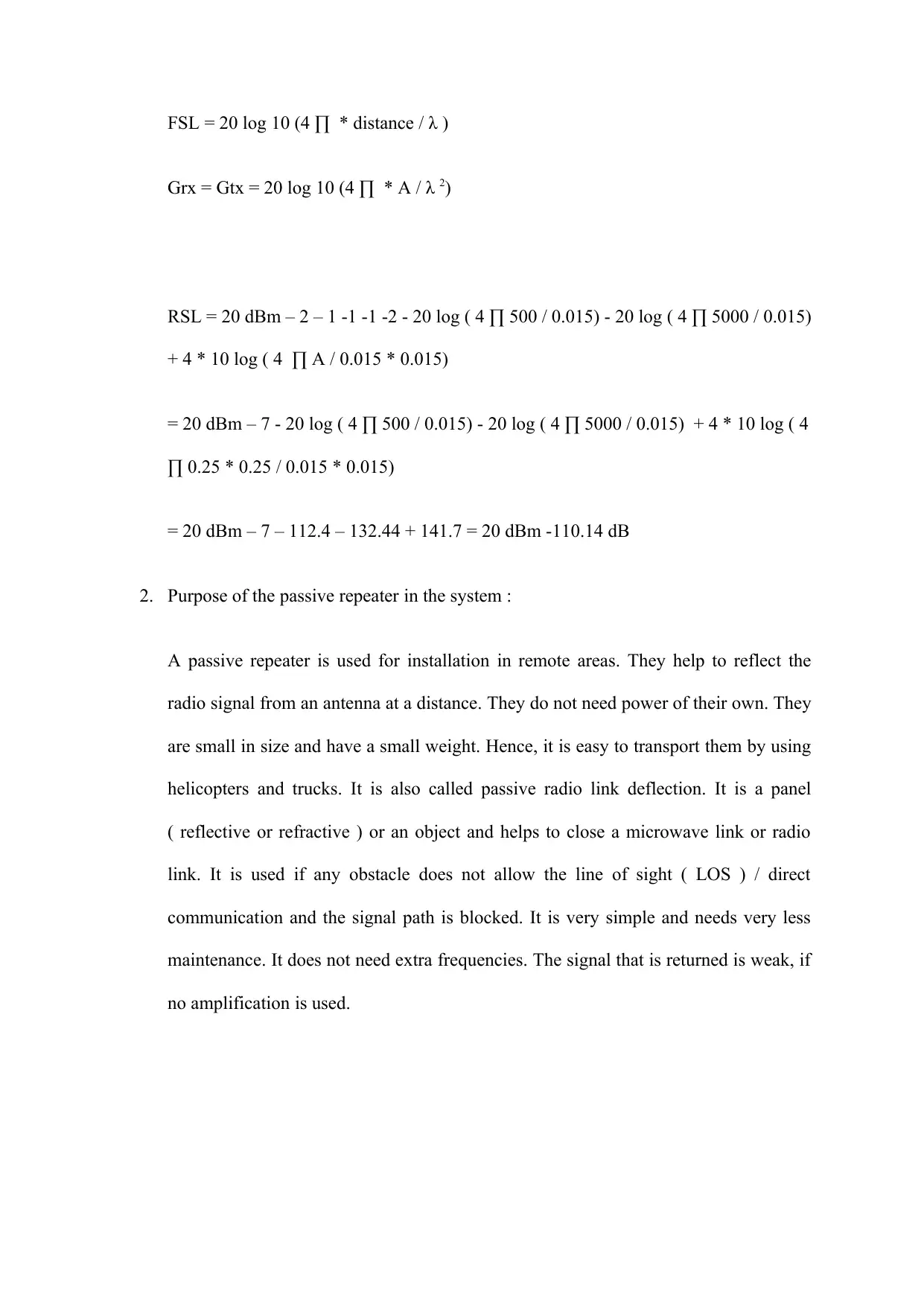
FSL = 20 log 10 (4 ∏ * distance / λ )
Grx = Gtx = 20 log 10 (4 ∏ * A / λ 2)
RSL = 20 dBm – 2 – 1 -1 -1 -2 - 20 log ( 4 ∏ 500 / 0.015) - 20 log ( 4 ∏ 5000 / 0.015)
+ 4 * 10 log ( 4 ∏ A / 0.015 * 0.015)
= 20 dBm – 7 - 20 log ( 4 ∏ 500 / 0.015) - 20 log ( 4 ∏ 5000 / 0.015) + 4 * 10 log ( 4
∏ 0.25 * 0.25 / 0.015 * 0.015)
= 20 dBm – 7 – 112.4 – 132.44 + 141.7 = 20 dBm -110.14 dB
2. Purpose of the passive repeater in the system :
A passive repeater is used for installation in remote areas. They help to reflect the
radio signal from an antenna at a distance. They do not need power of their own. They
are small in size and have a small weight. Hence, it is easy to transport them by using
helicopters and trucks. It is also called passive radio link deflection. It is a panel
( reflective or refractive ) or an object and helps to close a microwave link or radio
link. It is used if any obstacle does not allow the line of sight ( LOS ) / direct
communication and the signal path is blocked. It is very simple and needs very less
maintenance. It does not need extra frequencies. The signal that is returned is weak, if
no amplification is used.
Grx = Gtx = 20 log 10 (4 ∏ * A / λ 2)
RSL = 20 dBm – 2 – 1 -1 -1 -2 - 20 log ( 4 ∏ 500 / 0.015) - 20 log ( 4 ∏ 5000 / 0.015)
+ 4 * 10 log ( 4 ∏ A / 0.015 * 0.015)
= 20 dBm – 7 - 20 log ( 4 ∏ 500 / 0.015) - 20 log ( 4 ∏ 5000 / 0.015) + 4 * 10 log ( 4
∏ 0.25 * 0.25 / 0.015 * 0.015)
= 20 dBm – 7 – 112.4 – 132.44 + 141.7 = 20 dBm -110.14 dB
2. Purpose of the passive repeater in the system :
A passive repeater is used for installation in remote areas. They help to reflect the
radio signal from an antenna at a distance. They do not need power of their own. They
are small in size and have a small weight. Hence, it is easy to transport them by using
helicopters and trucks. It is also called passive radio link deflection. It is a panel
( reflective or refractive ) or an object and helps to close a microwave link or radio
link. It is used if any obstacle does not allow the line of sight ( LOS ) / direct
communication and the signal path is blocked. It is very simple and needs very less
maintenance. It does not need extra frequencies. The signal that is returned is weak, if
no amplification is used.
Secure Best Marks with AI Grader
Need help grading? Try our AI Grader for instant feedback on your assignments.
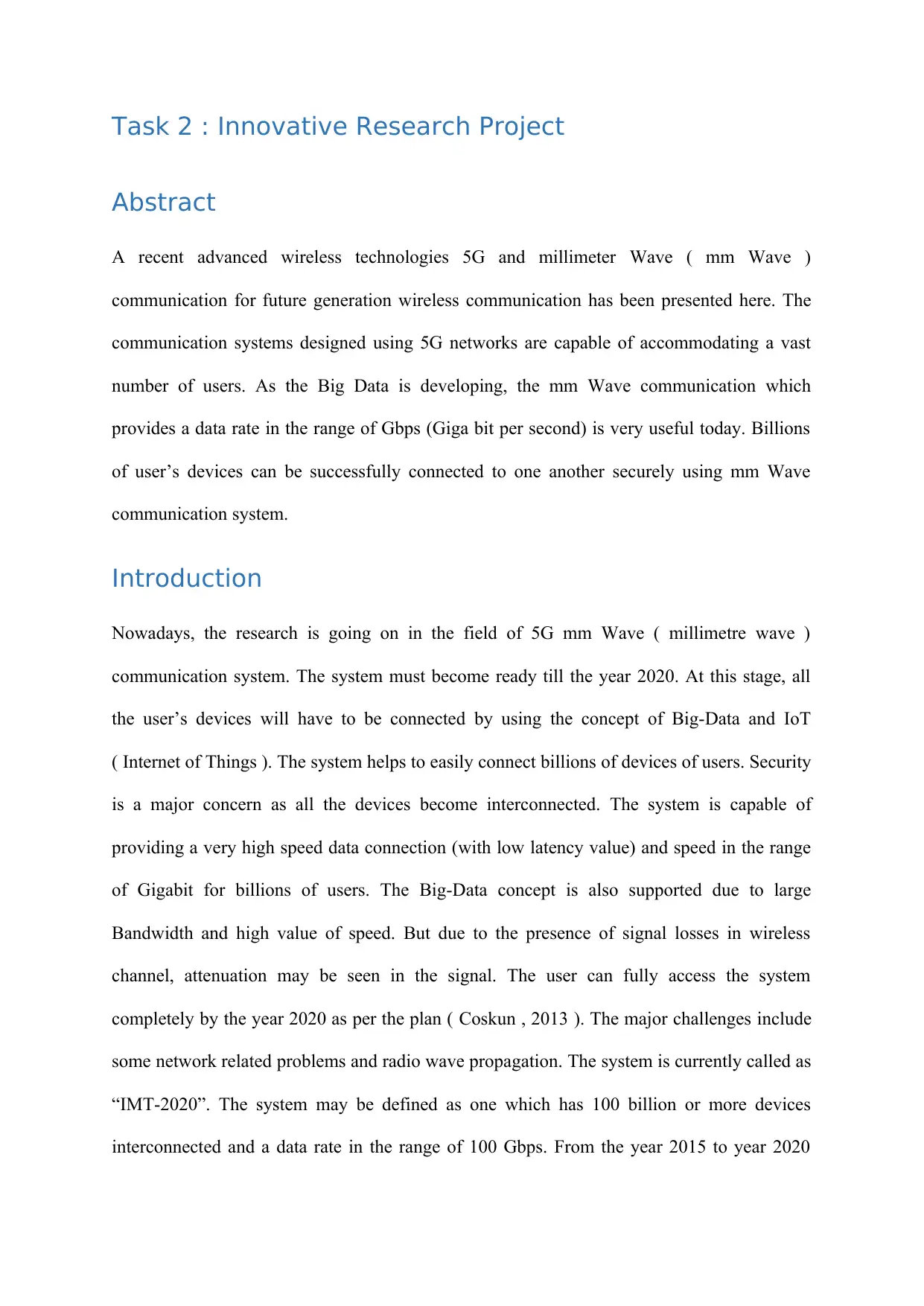
Task 2 : Innovative Research Project
Abstract
A recent advanced wireless technologies 5G and millimeter Wave ( mm Wave )
communication for future generation wireless communication has been presented here. The
communication systems designed using 5G networks are capable of accommodating a vast
number of users. As the Big Data is developing, the mm Wave communication which
provides a data rate in the range of Gbps (Giga bit per second) is very useful today. Billions
of user’s devices can be successfully connected to one another securely using mm Wave
communication system.
Introduction
Nowadays, the research is going on in the field of 5G mm Wave ( millimetre wave )
communication system. The system must become ready till the year 2020. At this stage, all
the user’s devices will have to be connected by using the concept of Big-Data and IoT
( Internet of Things ). The system helps to easily connect billions of devices of users. Security
is a major concern as all the devices become interconnected. The system is capable of
providing a very high speed data connection (with low latency value) and speed in the range
of Gigabit for billions of users. The Big-Data concept is also supported due to large
Bandwidth and high value of speed. But due to the presence of signal losses in wireless
channel, attenuation may be seen in the signal. The user can fully access the system
completely by the year 2020 as per the plan ( Coskun , 2013 ). The major challenges include
some network related problems and radio wave propagation. The system is currently called as
“IMT-2020”. The system may be defined as one which has 100 billion or more devices
interconnected and a data rate in the range of 100 Gbps. From the year 2015 to year 2020
Abstract
A recent advanced wireless technologies 5G and millimeter Wave ( mm Wave )
communication for future generation wireless communication has been presented here. The
communication systems designed using 5G networks are capable of accommodating a vast
number of users. As the Big Data is developing, the mm Wave communication which
provides a data rate in the range of Gbps (Giga bit per second) is very useful today. Billions
of user’s devices can be successfully connected to one another securely using mm Wave
communication system.
Introduction
Nowadays, the research is going on in the field of 5G mm Wave ( millimetre wave )
communication system. The system must become ready till the year 2020. At this stage, all
the user’s devices will have to be connected by using the concept of Big-Data and IoT
( Internet of Things ). The system helps to easily connect billions of devices of users. Security
is a major concern as all the devices become interconnected. The system is capable of
providing a very high speed data connection (with low latency value) and speed in the range
of Gigabit for billions of users. The Big-Data concept is also supported due to large
Bandwidth and high value of speed. But due to the presence of signal losses in wireless
channel, attenuation may be seen in the signal. The user can fully access the system
completely by the year 2020 as per the plan ( Coskun , 2013 ). The major challenges include
some network related problems and radio wave propagation. The system is currently called as
“IMT-2020”. The system may be defined as one which has 100 billion or more devices
interconnected and a data rate in the range of 100 Gbps. From the year 2015 to year 2020
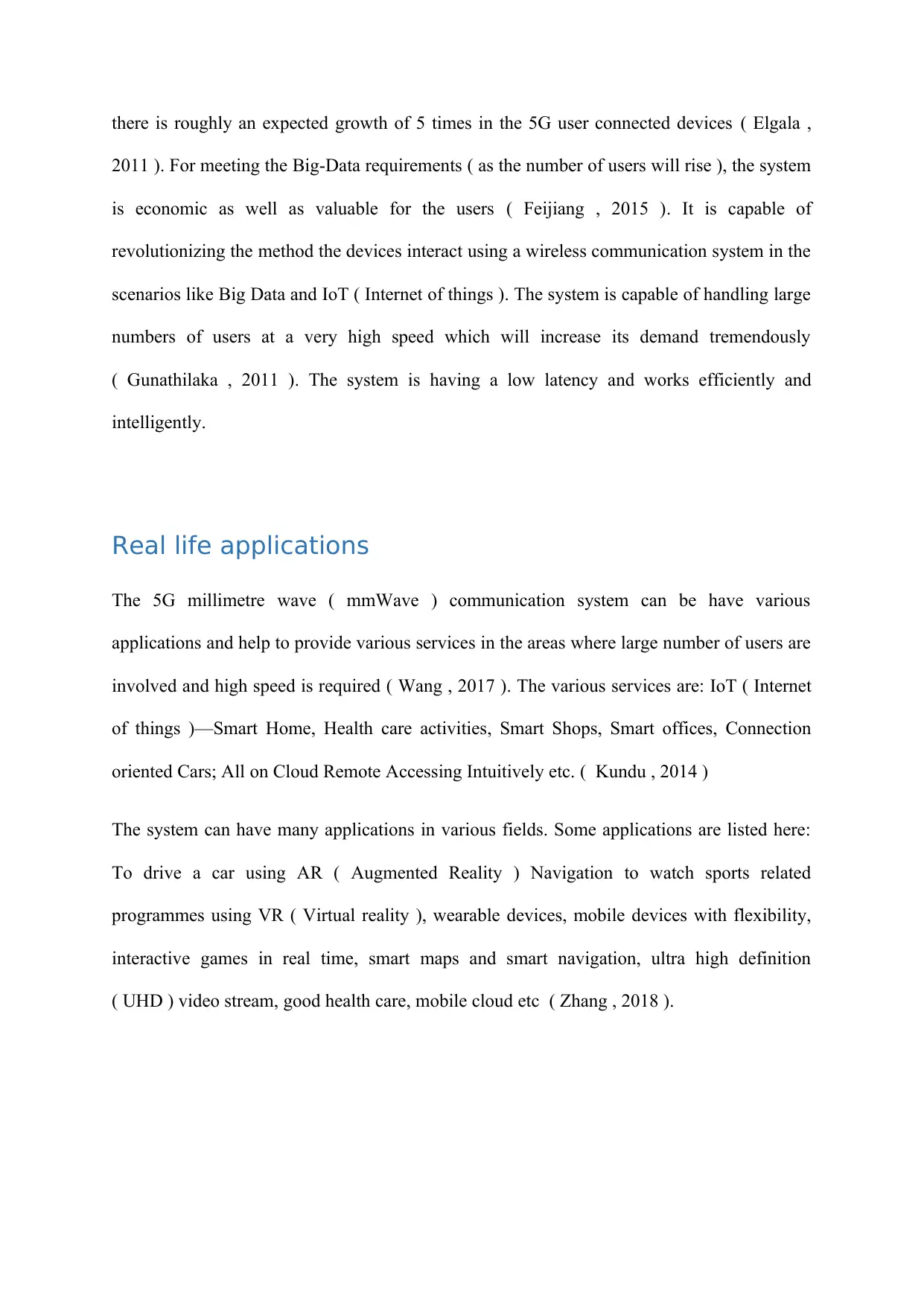
there is roughly an expected growth of 5 times in the 5G user connected devices ( Elgala ,
2011 ). For meeting the Big-Data requirements ( as the number of users will rise ), the system
is economic as well as valuable for the users ( Feijiang , 2015 ). It is capable of
revolutionizing the method the devices interact using a wireless communication system in the
scenarios like Big Data and IoT ( Internet of things ). The system is capable of handling large
numbers of users at a very high speed which will increase its demand tremendously
( Gunathilaka , 2011 ). The system is having a low latency and works efficiently and
intelligently.
Real life applications
The 5G millimetre wave ( mmWave ) communication system can be have various
applications and help to provide various services in the areas where large number of users are
involved and high speed is required ( Wang , 2017 ). The various services are: IoT ( Internet
of things )—Smart Home, Health care activities, Smart Shops, Smart offices, Connection
oriented Cars; All on Cloud Remote Accessing Intuitively etc. ( Kundu , 2014 )
The system can have many applications in various fields. Some applications are listed here:
To drive a car using AR ( Augmented Reality ) Navigation to watch sports related
programmes using VR ( Virtual reality ), wearable devices, mobile devices with flexibility,
interactive games in real time, smart maps and smart navigation, ultra high definition
( UHD ) video stream, good health care, mobile cloud etc ( Zhang , 2018 ).
2011 ). For meeting the Big-Data requirements ( as the number of users will rise ), the system
is economic as well as valuable for the users ( Feijiang , 2015 ). It is capable of
revolutionizing the method the devices interact using a wireless communication system in the
scenarios like Big Data and IoT ( Internet of things ). The system is capable of handling large
numbers of users at a very high speed which will increase its demand tremendously
( Gunathilaka , 2011 ). The system is having a low latency and works efficiently and
intelligently.
Real life applications
The 5G millimetre wave ( mmWave ) communication system can be have various
applications and help to provide various services in the areas where large number of users are
involved and high speed is required ( Wang , 2017 ). The various services are: IoT ( Internet
of things )—Smart Home, Health care activities, Smart Shops, Smart offices, Connection
oriented Cars; All on Cloud Remote Accessing Intuitively etc. ( Kundu , 2014 )
The system can have many applications in various fields. Some applications are listed here:
To drive a car using AR ( Augmented Reality ) Navigation to watch sports related
programmes using VR ( Virtual reality ), wearable devices, mobile devices with flexibility,
interactive games in real time, smart maps and smart navigation, ultra high definition
( UHD ) video stream, good health care, mobile cloud etc ( Zhang , 2018 ).
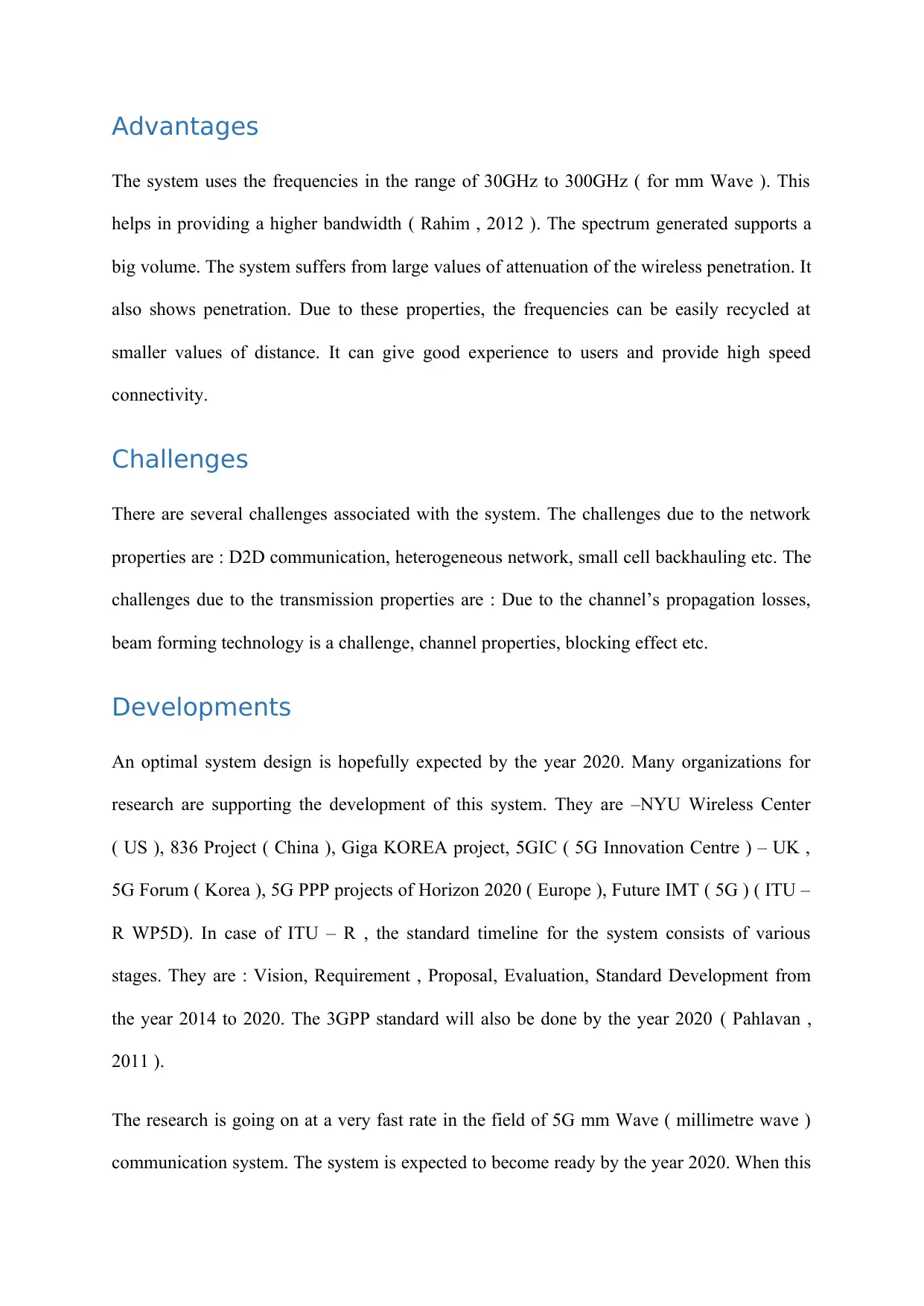
Advantages
The system uses the frequencies in the range of 30GHz to 300GHz ( for mm Wave ). This
helps in providing a higher bandwidth ( Rahim , 2012 ). The spectrum generated supports a
big volume. The system suffers from large values of attenuation of the wireless penetration. It
also shows penetration. Due to these properties, the frequencies can be easily recycled at
smaller values of distance. It can give good experience to users and provide high speed
connectivity.
Challenges
There are several challenges associated with the system. The challenges due to the network
properties are : D2D communication, heterogeneous network, small cell backhauling etc. The
challenges due to the transmission properties are : Due to the channel’s propagation losses,
beam forming technology is a challenge, channel properties, blocking effect etc.
Developments
An optimal system design is hopefully expected by the year 2020. Many organizations for
research are supporting the development of this system. They are –NYU Wireless Center
( US ), 836 Project ( China ), Giga KOREA project, 5GIC ( 5G Innovation Centre ) – UK ,
5G Forum ( Korea ), 5G PPP projects of Horizon 2020 ( Europe ), Future IMT ( 5G ) ( ITU –
R WP5D). In case of ITU – R , the standard timeline for the system consists of various
stages. They are : Vision, Requirement , Proposal, Evaluation, Standard Development from
the year 2014 to 2020. The 3GPP standard will also be done by the year 2020 ( Pahlavan ,
2011 ).
The research is going on at a very fast rate in the field of 5G mm Wave ( millimetre wave )
communication system. The system is expected to become ready by the year 2020. When this
The system uses the frequencies in the range of 30GHz to 300GHz ( for mm Wave ). This
helps in providing a higher bandwidth ( Rahim , 2012 ). The spectrum generated supports a
big volume. The system suffers from large values of attenuation of the wireless penetration. It
also shows penetration. Due to these properties, the frequencies can be easily recycled at
smaller values of distance. It can give good experience to users and provide high speed
connectivity.
Challenges
There are several challenges associated with the system. The challenges due to the network
properties are : D2D communication, heterogeneous network, small cell backhauling etc. The
challenges due to the transmission properties are : Due to the channel’s propagation losses,
beam forming technology is a challenge, channel properties, blocking effect etc.
Developments
An optimal system design is hopefully expected by the year 2020. Many organizations for
research are supporting the development of this system. They are –NYU Wireless Center
( US ), 836 Project ( China ), Giga KOREA project, 5GIC ( 5G Innovation Centre ) – UK ,
5G Forum ( Korea ), 5G PPP projects of Horizon 2020 ( Europe ), Future IMT ( 5G ) ( ITU –
R WP5D). In case of ITU – R , the standard timeline for the system consists of various
stages. They are : Vision, Requirement , Proposal, Evaluation, Standard Development from
the year 2014 to 2020. The 3GPP standard will also be done by the year 2020 ( Pahlavan ,
2011 ).
The research is going on at a very fast rate in the field of 5G mm Wave ( millimetre wave )
communication system. The system is expected to become ready by the year 2020. When this
Paraphrase This Document
Need a fresh take? Get an instant paraphrase of this document with our AI Paraphraser
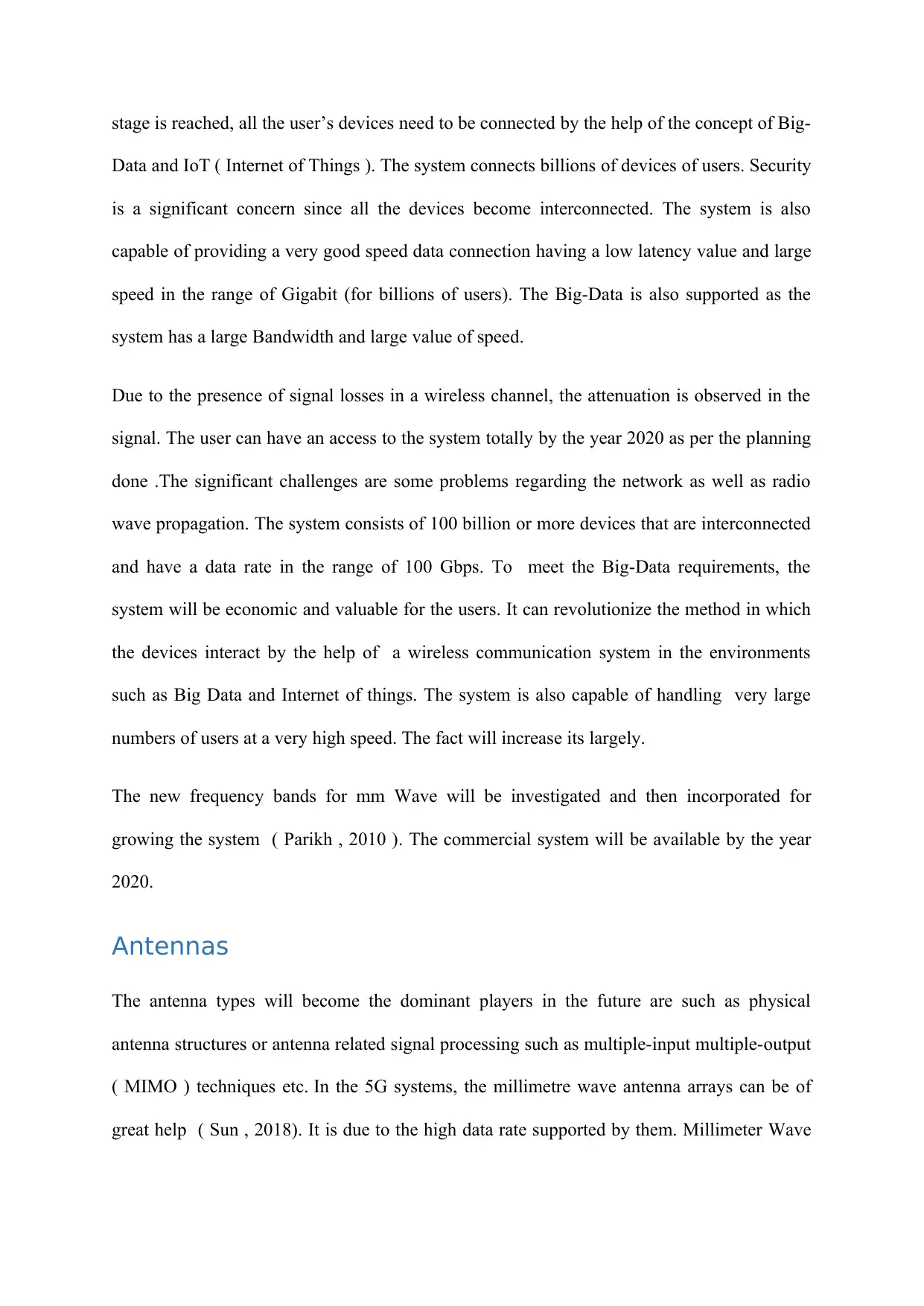
stage is reached, all the user’s devices need to be connected by the help of the concept of Big-
Data and IoT ( Internet of Things ). The system connects billions of devices of users. Security
is a significant concern since all the devices become interconnected. The system is also
capable of providing a very good speed data connection having a low latency value and large
speed in the range of Gigabit (for billions of users). The Big-Data is also supported as the
system has a large Bandwidth and large value of speed.
Due to the presence of signal losses in a wireless channel, the attenuation is observed in the
signal. The user can have an access to the system totally by the year 2020 as per the planning
done .The significant challenges are some problems regarding the network as well as radio
wave propagation. The system consists of 100 billion or more devices that are interconnected
and have a data rate in the range of 100 Gbps. To meet the Big-Data requirements, the
system will be economic and valuable for the users. It can revolutionize the method in which
the devices interact by the help of a wireless communication system in the environments
such as Big Data and Internet of things. The system is also capable of handling very large
numbers of users at a very high speed. The fact will increase its largely.
The new frequency bands for mm Wave will be investigated and then incorporated for
growing the system ( Parikh , 2010 ). The commercial system will be available by the year
2020.
Antennas
The antenna types will become the dominant players in the future are such as physical
antenna structures or antenna related signal processing such as multiple-input multiple-output
( MIMO ) techniques etc. In the 5G systems, the millimetre wave antenna arrays can be of
great help ( Sun , 2018). It is due to the high data rate supported by them. Millimeter Wave
Data and IoT ( Internet of Things ). The system connects billions of devices of users. Security
is a significant concern since all the devices become interconnected. The system is also
capable of providing a very good speed data connection having a low latency value and large
speed in the range of Gigabit (for billions of users). The Big-Data is also supported as the
system has a large Bandwidth and large value of speed.
Due to the presence of signal losses in a wireless channel, the attenuation is observed in the
signal. The user can have an access to the system totally by the year 2020 as per the planning
done .The significant challenges are some problems regarding the network as well as radio
wave propagation. The system consists of 100 billion or more devices that are interconnected
and have a data rate in the range of 100 Gbps. To meet the Big-Data requirements, the
system will be economic and valuable for the users. It can revolutionize the method in which
the devices interact by the help of a wireless communication system in the environments
such as Big Data and Internet of things. The system is also capable of handling very large
numbers of users at a very high speed. The fact will increase its largely.
The new frequency bands for mm Wave will be investigated and then incorporated for
growing the system ( Parikh , 2010 ). The commercial system will be available by the year
2020.
Antennas
The antenna types will become the dominant players in the future are such as physical
antenna structures or antenna related signal processing such as multiple-input multiple-output
( MIMO ) techniques etc. In the 5G systems, the millimetre wave antenna arrays can be of
great help ( Sun , 2018). It is due to the high data rate supported by them. Millimeter Wave
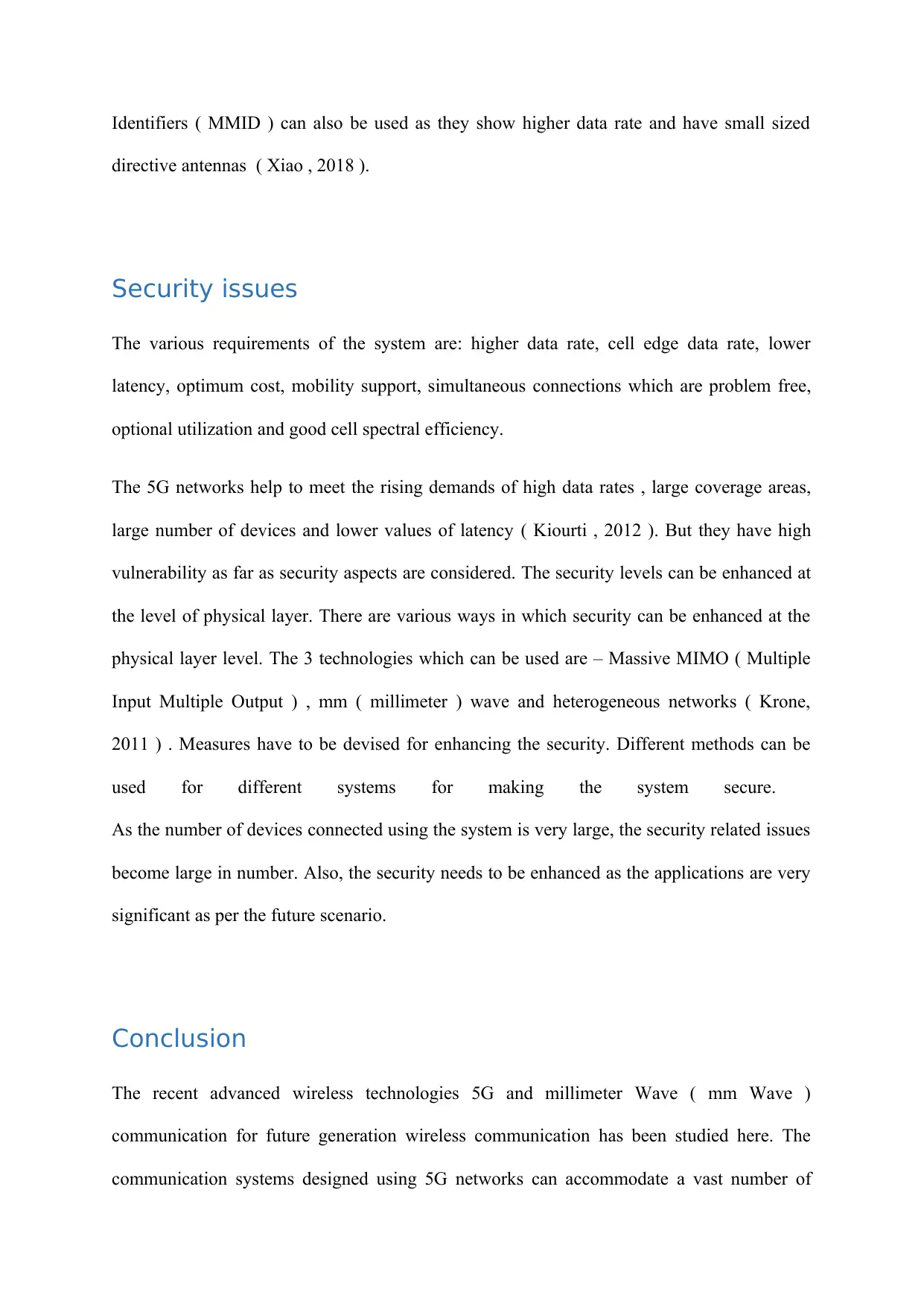
Identifiers ( MMID ) can also be used as they show higher data rate and have small sized
directive antennas ( Xiao , 2018 ).
Security issues
The various requirements of the system are: higher data rate, cell edge data rate, lower
latency, optimum cost, mobility support, simultaneous connections which are problem free,
optional utilization and good cell spectral efficiency.
The 5G networks help to meet the rising demands of high data rates , large coverage areas,
large number of devices and lower values of latency ( Kiourti , 2012 ). But they have high
vulnerability as far as security aspects are considered. The security levels can be enhanced at
the level of physical layer. There are various ways in which security can be enhanced at the
physical layer level. The 3 technologies which can be used are – Massive MIMO ( Multiple
Input Multiple Output ) , mm ( millimeter ) wave and heterogeneous networks ( Krone,
2011 ) . Measures have to be devised for enhancing the security. Different methods can be
used for different systems for making the system secure.
As the number of devices connected using the system is very large, the security related issues
become large in number. Also, the security needs to be enhanced as the applications are very
significant as per the future scenario.
Conclusion
The recent advanced wireless technologies 5G and millimeter Wave ( mm Wave )
communication for future generation wireless communication has been studied here. The
communication systems designed using 5G networks can accommodate a vast number of
directive antennas ( Xiao , 2018 ).
Security issues
The various requirements of the system are: higher data rate, cell edge data rate, lower
latency, optimum cost, mobility support, simultaneous connections which are problem free,
optional utilization and good cell spectral efficiency.
The 5G networks help to meet the rising demands of high data rates , large coverage areas,
large number of devices and lower values of latency ( Kiourti , 2012 ). But they have high
vulnerability as far as security aspects are considered. The security levels can be enhanced at
the level of physical layer. There are various ways in which security can be enhanced at the
physical layer level. The 3 technologies which can be used are – Massive MIMO ( Multiple
Input Multiple Output ) , mm ( millimeter ) wave and heterogeneous networks ( Krone,
2011 ) . Measures have to be devised for enhancing the security. Different methods can be
used for different systems for making the system secure.
As the number of devices connected using the system is very large, the security related issues
become large in number. Also, the security needs to be enhanced as the applications are very
significant as per the future scenario.
Conclusion
The recent advanced wireless technologies 5G and millimeter Wave ( mm Wave )
communication for future generation wireless communication has been studied here. The
communication systems designed using 5G networks can accommodate a vast number of
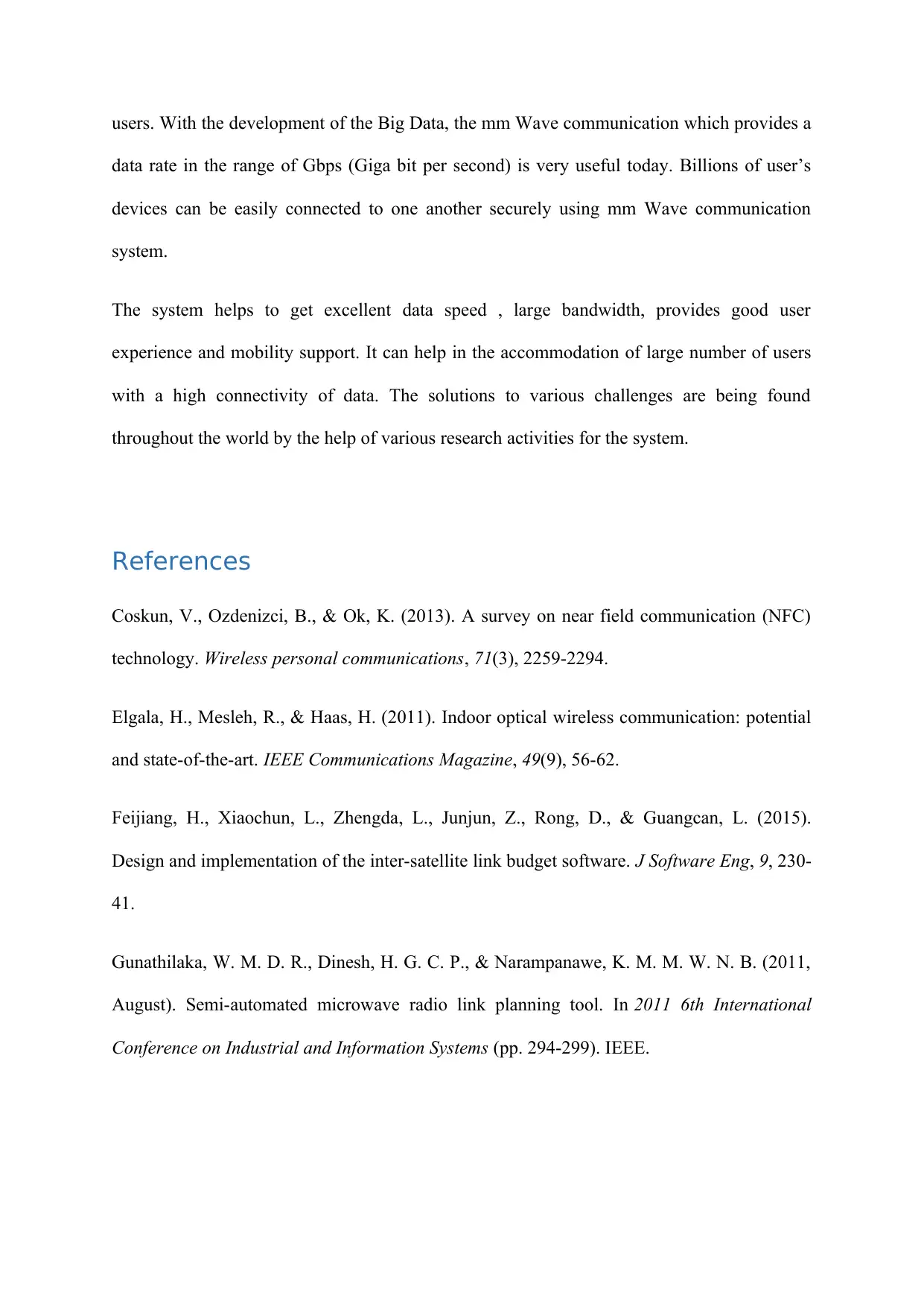
users. With the development of the Big Data, the mm Wave communication which provides a
data rate in the range of Gbps (Giga bit per second) is very useful today. Billions of user’s
devices can be easily connected to one another securely using mm Wave communication
system.
The system helps to get excellent data speed , large bandwidth, provides good user
experience and mobility support. It can help in the accommodation of large number of users
with a high connectivity of data. The solutions to various challenges are being found
throughout the world by the help of various research activities for the system.
References
Coskun, V., Ozdenizci, B., & Ok, K. (2013). A survey on near field communication (NFC)
technology. Wireless personal communications, 71(3), 2259-2294.
Elgala, H., Mesleh, R., & Haas, H. (2011). Indoor optical wireless communication: potential
and state-of-the-art. IEEE Communications Magazine, 49(9), 56-62.
Feijiang, H., Xiaochun, L., Zhengda, L., Junjun, Z., Rong, D., & Guangcan, L. (2015).
Design and implementation of the inter-satellite link budget software. J Software Eng, 9, 230-
41.
Gunathilaka, W. M. D. R., Dinesh, H. G. C. P., & Narampanawe, K. M. M. W. N. B. (2011,
August). Semi-automated microwave radio link planning tool. In 2011 6th International
Conference on Industrial and Information Systems (pp. 294-299). IEEE.
data rate in the range of Gbps (Giga bit per second) is very useful today. Billions of user’s
devices can be easily connected to one another securely using mm Wave communication
system.
The system helps to get excellent data speed , large bandwidth, provides good user
experience and mobility support. It can help in the accommodation of large number of users
with a high connectivity of data. The solutions to various challenges are being found
throughout the world by the help of various research activities for the system.
References
Coskun, V., Ozdenizci, B., & Ok, K. (2013). A survey on near field communication (NFC)
technology. Wireless personal communications, 71(3), 2259-2294.
Elgala, H., Mesleh, R., & Haas, H. (2011). Indoor optical wireless communication: potential
and state-of-the-art. IEEE Communications Magazine, 49(9), 56-62.
Feijiang, H., Xiaochun, L., Zhengda, L., Junjun, Z., Rong, D., & Guangcan, L. (2015).
Design and implementation of the inter-satellite link budget software. J Software Eng, 9, 230-
41.
Gunathilaka, W. M. D. R., Dinesh, H. G. C. P., & Narampanawe, K. M. M. W. N. B. (2011,
August). Semi-automated microwave radio link planning tool. In 2011 6th International
Conference on Industrial and Information Systems (pp. 294-299). IEEE.
Secure Best Marks with AI Grader
Need help grading? Try our AI Grader for instant feedback on your assignments.
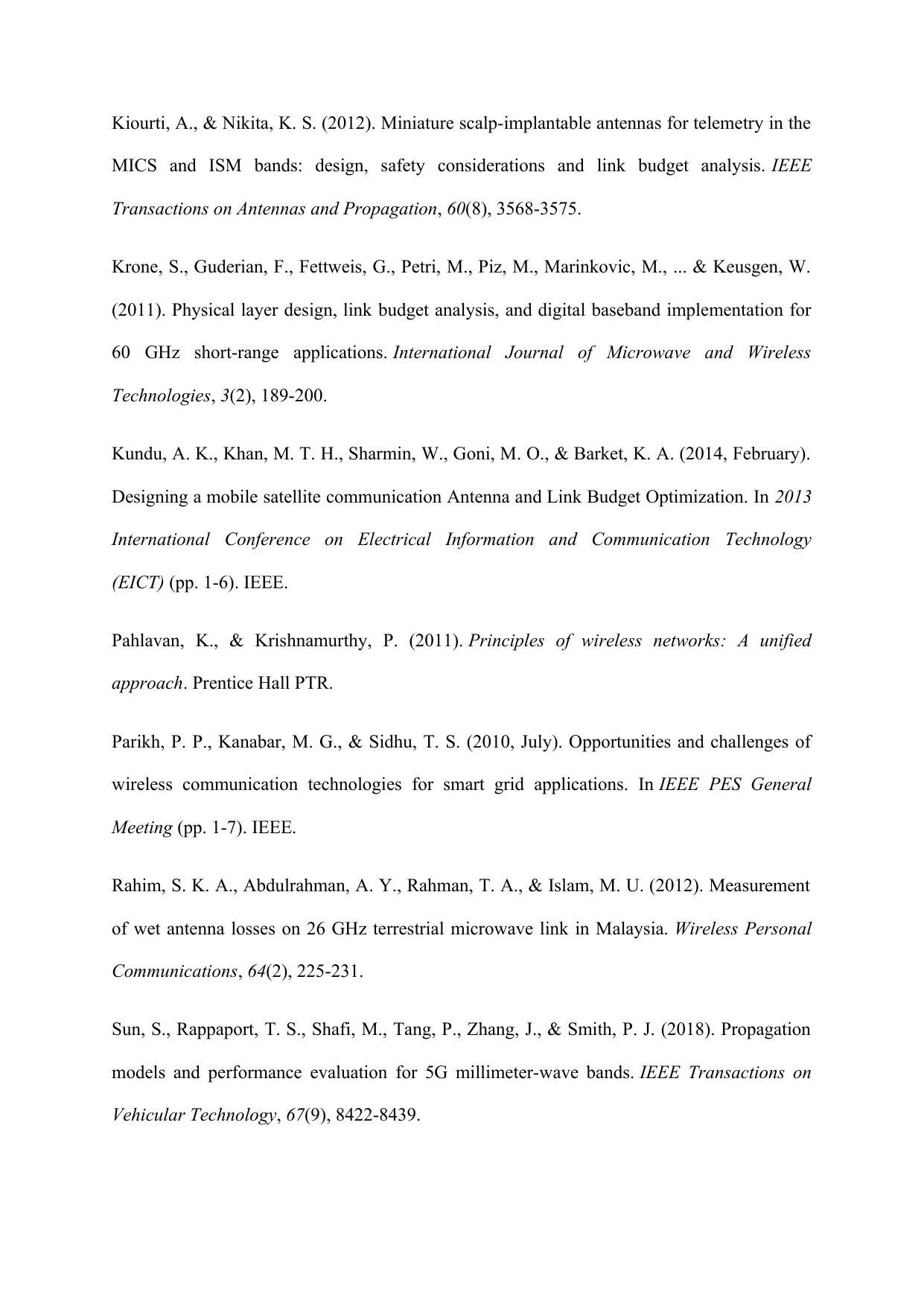
Kiourti, A., & Nikita, K. S. (2012). Miniature scalp-implantable antennas for telemetry in the
MICS and ISM bands: design, safety considerations and link budget analysis. IEEE
Transactions on Antennas and Propagation, 60(8), 3568-3575.
Krone, S., Guderian, F., Fettweis, G., Petri, M., Piz, M., Marinkovic, M., ... & Keusgen, W.
(2011). Physical layer design, link budget analysis, and digital baseband implementation for
60 GHz short-range applications. International Journal of Microwave and Wireless
Technologies, 3(2), 189-200.
Kundu, A. K., Khan, M. T. H., Sharmin, W., Goni, M. O., & Barket, K. A. (2014, February).
Designing a mobile satellite communication Antenna and Link Budget Optimization. In 2013
International Conference on Electrical Information and Communication Technology
(EICT) (pp. 1-6). IEEE.
Pahlavan, K., & Krishnamurthy, P. (2011). Principles of wireless networks: A unified
approach. Prentice Hall PTR.
Parikh, P. P., Kanabar, M. G., & Sidhu, T. S. (2010, July). Opportunities and challenges of
wireless communication technologies for smart grid applications. In IEEE PES General
Meeting (pp. 1-7). IEEE.
Rahim, S. K. A., Abdulrahman, A. Y., Rahman, T. A., & Islam, M. U. (2012). Measurement
of wet antenna losses on 26 GHz terrestrial microwave link in Malaysia. Wireless Personal
Communications, 64(2), 225-231.
Sun, S., Rappaport, T. S., Shafi, M., Tang, P., Zhang, J., & Smith, P. J. (2018). Propagation
models and performance evaluation for 5G millimeter-wave bands. IEEE Transactions on
Vehicular Technology, 67(9), 8422-8439.
MICS and ISM bands: design, safety considerations and link budget analysis. IEEE
Transactions on Antennas and Propagation, 60(8), 3568-3575.
Krone, S., Guderian, F., Fettweis, G., Petri, M., Piz, M., Marinkovic, M., ... & Keusgen, W.
(2011). Physical layer design, link budget analysis, and digital baseband implementation for
60 GHz short-range applications. International Journal of Microwave and Wireless
Technologies, 3(2), 189-200.
Kundu, A. K., Khan, M. T. H., Sharmin, W., Goni, M. O., & Barket, K. A. (2014, February).
Designing a mobile satellite communication Antenna and Link Budget Optimization. In 2013
International Conference on Electrical Information and Communication Technology
(EICT) (pp. 1-6). IEEE.
Pahlavan, K., & Krishnamurthy, P. (2011). Principles of wireless networks: A unified
approach. Prentice Hall PTR.
Parikh, P. P., Kanabar, M. G., & Sidhu, T. S. (2010, July). Opportunities and challenges of
wireless communication technologies for smart grid applications. In IEEE PES General
Meeting (pp. 1-7). IEEE.
Rahim, S. K. A., Abdulrahman, A. Y., Rahman, T. A., & Islam, M. U. (2012). Measurement
of wet antenna losses on 26 GHz terrestrial microwave link in Malaysia. Wireless Personal
Communications, 64(2), 225-231.
Sun, S., Rappaport, T. S., Shafi, M., Tang, P., Zhang, J., & Smith, P. J. (2018). Propagation
models and performance evaluation for 5G millimeter-wave bands. IEEE Transactions on
Vehicular Technology, 67(9), 8422-8439.
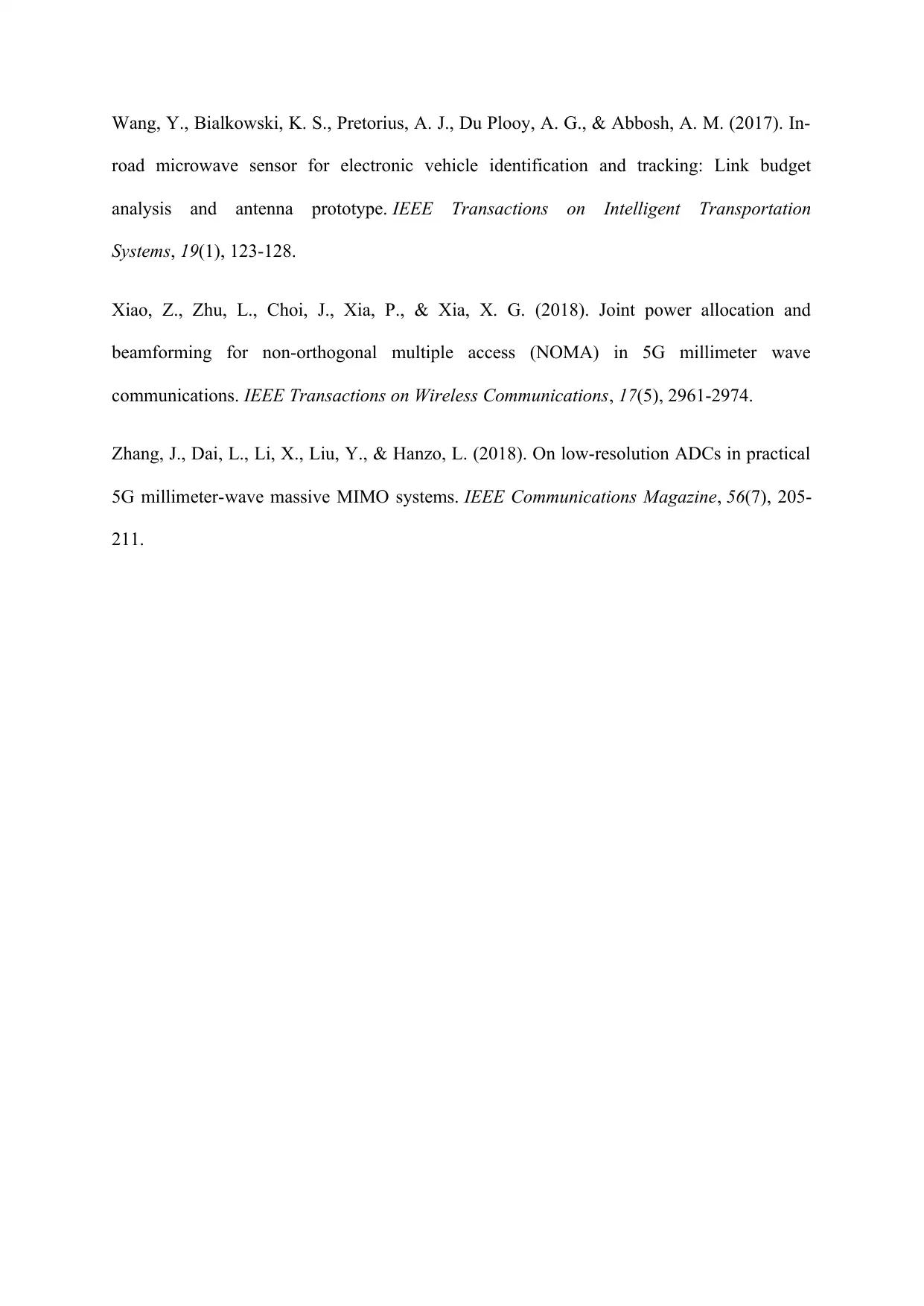
Wang, Y., Bialkowski, K. S., Pretorius, A. J., Du Plooy, A. G., & Abbosh, A. M. (2017). In-
road microwave sensor for electronic vehicle identification and tracking: Link budget
analysis and antenna prototype. IEEE Transactions on Intelligent Transportation
Systems, 19(1), 123-128.
Xiao, Z., Zhu, L., Choi, J., Xia, P., & Xia, X. G. (2018). Joint power allocation and
beamforming for non-orthogonal multiple access (NOMA) in 5G millimeter wave
communications. IEEE Transactions on Wireless Communications, 17(5), 2961-2974.
Zhang, J., Dai, L., Li, X., Liu, Y., & Hanzo, L. (2018). On low-resolution ADCs in practical
5G millimeter-wave massive MIMO systems. IEEE Communications Magazine, 56(7), 205-
211.
road microwave sensor for electronic vehicle identification and tracking: Link budget
analysis and antenna prototype. IEEE Transactions on Intelligent Transportation
Systems, 19(1), 123-128.
Xiao, Z., Zhu, L., Choi, J., Xia, P., & Xia, X. G. (2018). Joint power allocation and
beamforming for non-orthogonal multiple access (NOMA) in 5G millimeter wave
communications. IEEE Transactions on Wireless Communications, 17(5), 2961-2974.
Zhang, J., Dai, L., Li, X., Liu, Y., & Hanzo, L. (2018). On low-resolution ADCs in practical
5G millimeter-wave massive MIMO systems. IEEE Communications Magazine, 56(7), 205-
211.
1 out of 12
Related Documents
Your All-in-One AI-Powered Toolkit for Academic Success.
+13062052269
info@desklib.com
Available 24*7 on WhatsApp / Email
![[object Object]](/_next/static/media/star-bottom.7253800d.svg)
Unlock your academic potential
© 2024 | Zucol Services PVT LTD | All rights reserved.




